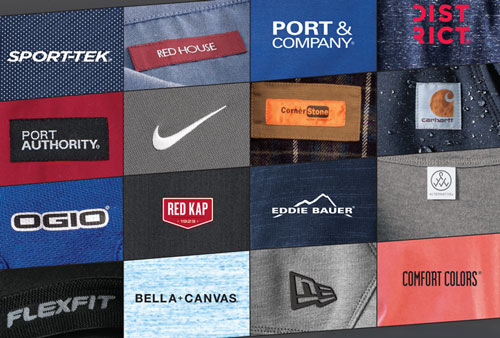How Branded Clothing Can Boost Confidence Through Fabric and Feel
How Branded Clothing Can Boost Confidence Through Fabric and Feel
Blog Article
Comprehending Clothing: The Significance of Material Selections in Your Closet
The selection of fabric in clothes plays a critical duty in both aesthetics and capability. Various materials supply differing degrees of breathability, durability, and convenience, straight affecting the user's experience. Recognizing these nuances can improve one's closet significantly. Yet, lots of neglect exactly how these choices can influence not just individual design, yet also sustainability. What textile decisions could redefine your closet and straighten it with both design and obligation?
The Duty of Material in vogue and Performance

Typical Material Kinds and Their Characteristics
When choosing garments, comprehending the characteristics of common fabric kinds is essential for making notified choices. Cotton, a widely-used natural fiber, is known for its breathability, gentleness, and convenience, making it suitable for casual wear and day-to-day garments. Linen, one more all-natural option, boasts excellent moisture-wicking homes and a distinct texture, perfect for warm climates.Wool, frequently preferred for its warmth and toughness, differs in fineness; merino woollen is soft versus the skin, while coarser kinds are used for outerwear. Artificial textiles like polyester and nylon provide resilience and resistance to wrinkles, making them popular for activewear and travel garments. Blends, which integrate artificial and all-natural fibers, can improve functionality while keeping comfort. By recognizing these fabric features, individuals can choose apparel that aligns with their lifestyle and aesthetic preferences.
Breathability and Comfort: Picking the Right Fabrics for Different Environments
Selecting the appropriate materials for various climates can substantially boost convenience and total wearability. Breathable materials are necessary in hot climates, as they allow air blood circulation and dampness evaporation. Fabrics such as cotton, bed linen, and moisture-wicking synthetics properly draw sweat far from the body, maintaining the wearer cool and completely dry. Conversely, in colder climates, thicker materials like woollen or fleece provide insulation while preserving breathability, ensuring heat without overheating.Additionally, the option of material weight plays an important function; light-weight fabrics are better for summer season, whereas much heavier options are suited for winter season wear. Understanding the distinct properties of each textile allows individuals to dress appropriately for differing climate condition. Inevitably, selecting comfy and breathable materials customized to certain environments can substantially improve everyday comfort and enhance the general experience of using clothes.
Sturdiness and Treatment: Exactly How Fabric Impacts Long Life of Your Wardrobe
Selecting the appropriate materials can significantly influence the resilience and treatment needs of a wardrobe. Fabrics such as cotton and polyester are recognized for their strength and convenience of maintenance, making them ideal for everyday wear. In comparison, delicate materials like silk and shoelace require more cautious handling and specialized cleaning methods, which can raise the moment and initiative needed for care. Branded Clothing.Durability is additionally influenced by the fabric's weave and surface; securely woven materials often tend to stand up to damage much better than loosely woven options. Additionally, synthetic blends commonly supply improved sturdiness, combining the most effective qualities of multiple fibers.Understanding the treatment instructions for each and every fabric is important, as improper washing or drying can result in premature wear. Inevitably, choosing resilient products can lead to a longer-lasting wardrobe, decreasing the regularity of replacements and adding to an extra lasting style choice
The Influence of Fabric on Fit and Shape

Sustainable Material Choices: Making Eco-Friendly Choices
The effect of fabric expands past fit and silhouette to include ecological aspects, prompting an expanding interest in lasting textile options. Environmentally friendly textiles, such as organic cotton, hemp, and Tencel, are getting traction among customers that focus on sustainability in their closets. These materials are commonly created with less chemicals and water, lowering their environmental footprint.Additionally, recycled materials, made from post-consumer waste, use an ingenious remedy to the textile market's air pollution issue. Brands progressively accept transparency in their sourcing techniques, enabling customers to make educated decisions regarding their purchases.Choosing lasting textiles not just sustains honest methods however likewise motivates the style industry to adopt see this site more responsible manufacturing approaches. As awareness of environmental problems climbs, individuals are advised to review the lasting impact of their fabric options, fostering a movement in the direction of a much more ecologically conscious and sustainable method to style.
Boosting Style: Just How Fabric Can Transform an Outfit
While numerous may focus on shade and cut when picking an outfit, the choice of fabric plays an essential role in elevating style and enhancing general appearance. Various products communicate distinct state of minds and messages; for instance, silk emanates luxury and refinement, while denim provides an informal, unwinded vibe. The structure and drape of a fabric can drastically modify the shape, with organized fabrics providing a refined look and softer ones creating an extra fluid, unwinded aesthetic.Moreover, the weight of the material influences wearability across periods. Lightweight materials like linen and cotton are perfect for summer season, while larger materials such as woollen and velour offer heat and beauty in chillier months. Recognizing fabric residential or commercial properties, such as breathability and stretch, also empowers people to make informed choices that enhance comfort without jeopardizing style. Inevitably, the best material can transform an attire from ordinary to amazing, making it a vital factor to consider in any type of wardrobe.
Often Asked Questions
How Do I Identify the Textile Material of My Clothing?
To determine material content, one can examine care labels, conduct melt examinations for fiber identification, or seek advice from material examples. These approaches assist distinguish materials, making certain notified selections for garments treatment and upkeep in day-to-day wear.
Can Textile Choice Affect My Mood or Confidence?
Fabric choice can substantially impact an individual's state of mind and self-confidence. Branded Clothing. Certain materials might stimulate feelings of convenience or beauty, while others can really feel limiting or uncomplimentary, eventually affecting self-perception and psychological wellness throughout the day
What Fabrics Are Ideal for Sensitive Skin?
For individuals with delicate skin, natural textiles like bamboo, bed linen, and cotton are often recommended. These materials are breathable, hypoallergenic, and less most likely to cause inflammation, making them appropriate choices for convenience and skin health.
Just how Do I Effectively Wash and Care for Different Fabrics?
To appropriately care and wash for various materials, one should think about each material's certain demands, including temperature settings, cleaning agents, and drying techniques, ensuring longevity and maintaining the fabric's initial qualities for ideal usage.
Are There Certain Fabrics for Athletic or Performance Wear?
Sports or performance wear usually get more uses materials such as spandex, polyester, and nylon. These products are developed for moisture-wicking, breathability, and flexibility, improving movement and comfort throughout physical activities while supplying durability and assistance. Alternatively, in colder environments, thicker textiles like woollen or fleece offer insulation while preserving breathability, making certain warmth without overheating.Additionally, the option of textile weight plays a crucial role; light-weight materials are preferable for summer, whereas larger alternatives are matched for winter season wear. In contrast, delicate products like silk and shoelace require even more careful handling and specialized cleaning techniques, which can increase the time and initiative needed for care.Durability is also influenced by the fabric's weave and finish; firmly woven fabrics have imp source a tendency to stand up to wear and tear better than loosely woven choices. In comparison, rigid fabrics can limit motion however supply a classic, polished look.Moreover, the thickness and structure of the material can influence the aesthetic understanding of body shape. The impact of fabric extends beyond fit and silhouette to encompass ecological aspects, prompting an expanding rate of interest in lasting fabric options. The structure and drape of a textile can significantly change the shape, with organized materials supplying a sleek appearance and softer ones developing a more fluid, relaxed aesthetic.Moreover, the weight of the material affects wearability throughout periods.
Report this page